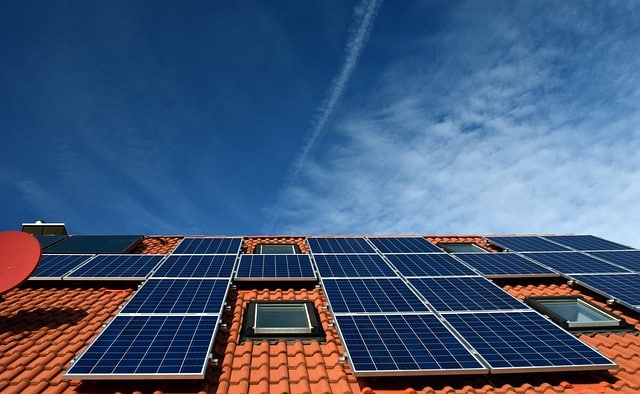Introduction – Cost of Renewable Vs Non-Renewable Energy
Today we’re going to consider the cost of renewable vs non-renewable energy. Energy is a fundamental requirement for any business or household. Energy is used in the form of electricity, gas and oil to power the appliances and equipment that we use every day. It is important to understand the cost associated with using these different forms of energy so that you can make an informed decision on what type of energy source would be best for you.

Renewables Have High Upfront Costs Compared To The Grid
Upfront costs are the cost of purchasing and installing the renewable energy system, such as solar panels, wind turbines, and geothermal systems. Operating costs include the cost of maintaining the system, such as repair and replacement of components, as well as ongoing energy costs associated with the system. The upfront costs of renewable energy are more expensive than grid energy, as the equipment and installation needed to get the system up and running can be costly.
However, the long-term savings from renewable energy can outweigh the initial cost, as you will no longer have to pay for monthly energy bills. Grid energy can be more affordable in terms of upfront costs, as the infrastructure already exists and is ready to use. However, the ongoing cost of grid energy is higher than renewable energy, as the cost of electricity from the grid can increase over time. There are other costs associated with renewables – let’s take a look at them.
Breakdown Of The Cost Of Renewables
1. Upfront capital cost: This is the most significant cost factor when it comes to renewable energy. It includes the cost of purchasing and installing the necessary equipment and infrastructure, such as solar panels, wind turbines, etc.
2. Maintenance costs: This includes the cost of operating and maintaining the equipment and infrastructure, such as regular maintenance and repairs.
3. Fuel costs: Renewable energy sources, such as solar and wind, require no fuel, which can significantly reduce their overall costs. However, some renewable energy sources, such as biomass and geothermal, require fuel to generate electricity.
4. Grid connection costs: This refers to the cost of connecting the power generated from renewable energy sources with the existing power grid.
5. Financing costs: This includes the cost of borrowing money to finance the installation of renewable energy systems.
6. Tax credits and incentives: Governments often provide incentives and tax credits to encourage the development of renewable energy sources. These incentives can significantly reduce the cost of renewable energy.
Energy Is A Necessary Cost Of Living
You may be surprised to learn that energy is a necessary cost of living. The price of energy affects the cost of food, clothing, transportation, and other things we need in order to survive. The price of energy is also closely tied to the way our economy works. A country’s economic resilience depends on how much its citizens spend on energy and how they get it. If you have lots of oil or coal in your country (or are nearby an oil-producing country), then your economy will be more resilient than one without such resources.
Types Of Renewable Energy For Home
There’s a good intro to the types of renewable energy here. Renewable energy is the type of energy that can be replenished naturally at a faster rate than it is consumed. Examples include solar, wind, hydropower and biomass. Renewable energy sources are renewable because they will not run out if used sustainably. This means that if we use these resources wisely, they will not be depleted or used up forever. In fact, there are many ways to generate electricity from conventional non-renewable sources like coal or natural gas – but none of them can compare to zero emissions technologies for generating electricity from solar power or wind power! We cover solar panels thoroughly here. In order to compare the cost of renewable vs non-renewable energy you want to focus on exactly which energy source to use.
More On Upfront Costs Of Renewable Energy
If you are considering installing a renewable energy system on your property, it is important to understand the costs associated with that installation. Once installed, renewables can be cost effective and significantly reduce your carbon footprint. But first you need to consider all the costs involved in installing solar panels or wind turbines, including:
- Permits and approvals for your project
- The actual installation of the technology itself
The upfront cost of installing a renewable energy system will vary depending on what type of system you choose and where you live. In general though, solar photovoltaic (PV) systems are typically more expensive than wind turbines but less expensive than ground source heat pumps or geothermal heating systems.
But … Renewable Energy Results In Lower Bills
As a result of the lower costs associated with renewable energy, your monthly bills will be significantly lower. This is true for electricity, gas and heating bills as well as water and food bills.

Less Maintenance Is Needed For Renewable Energy Systems
Renewable energy systems are more reliable, efficient and require less maintenance. Hence there is an upfront cost and then afterward, a gradual reduction in the cost of renewable vs non-renewable energy.
Renewable energy systems have a higher level of reliability than fossil fuel-based power plants. For example, when the sun shines or wind blows, you can count on renewable energy to be there for you. In contrast, fossil fuel-based power plants don’t always produce electricity at the moment you want it because they depend on natural gas or coal supplies that are delivered via pipelines or by train. In addition to being more reliable than conventional sources of energy generation, many renewable technologies are also more efficient at converting the sun’s rays into usable electricity compared with traditional fossil fuel power plants which require large amounts of water just to keep them cool and operating efficiently enough so that they won’t catch fire!
For this reason alone (and there are many others), most people agree that investing in a clean energy system such as solar panels makes sense not only because it reduces our carbon footprint but also because these systems require less maintenance overall due largely because their components last longer without breaking down like those found within other types of power generation equipment.”
Renewable Energy Costs Less In The Long Run.
Renewable energy is a smart choice for your utility bill. In addition to the energy production costs being lower, there are also several other factors that make it a more cost-effective way to power your home or business.
- Renewable energy sources produce less waste and pollution than non-renewable sources, which means you won’t have to be concerned about paying for cleanup or disposal of any harmful byproducts generated during production.
- Maintenance costs are lower because unlike fossil fuel sources like coal or oil, there’s no need for new fuel when using renewable energy systems. Because they don’t use raw materials that could run out someday (like uranium) they’re also unlikely ever needing replacing as well! This can result in huge savings over time since there won’t be any unexpected maintenance fees popping up every few years either
Government Incentives For Renewable Energy.
There are a number of incentives for example: federal and state incentives, tax credits, rebates, grants and low interest loans. Some states have special programs for financing renewable energy projects, such as the New Mexico Solar Loan Program and the California Self-Generation Incentive Program. The federal government also offers low-interest loans through the U.S. Department of Agriculture Rural Energy for America Program (REAP), which provides grants to help farmers purchase renewable energy systems or make energy efficiency upgrades on their farms.
Loans are available for items like wind turbines, solar panels and other machinery used in renewable power generation; biogas digesters; hydroelectric generators; biodiesel production facilities; methane digesters; fuel cells that run on waste cooking oil or animal fat; wastewater treatment plants that use anaerobic digestion techniques; propane-fueled vehicles running on alternative fuels made from renewable resources such as corn stalks or soybean oil instead of petroleum products like gasoline or diesel fuel.
Carbon Emissions And Renewable Energy
The importance of renewable energy is becoming more apparent as we suffer the consequences of climate change. Renewable energy sources do not produce carbon emissions, which are a major contributor to global warming and other environmental problems.
The availability of clean, sustainable, and renewable forms of energy has been increasing over time. Solar power is one example; although it’s still in its infancy, it’s growing rapidly thanks to advances in technology that make it more efficient than ever before.
Renewable sources like solar energy have many benefits: they’re cleaner for our environment; they don’t require expensive infrastructure upgrades like new transmission lines; and they’re reliable because they depend on natural forces we can count on year-round (like sunlight).
Conclusion – Cost Of Renewable Vs Non-Renewable Energy
If we want to continue living in a world with abundant resources, renewable energy is the way to go. While some might argue that it costs too much and others that it doesn’t work well enough, the facts show otherwise: renewable energy is cheaper and more efficient than conventional methods of producing power. In addition, government incentives are available for those who want solar panels or other types of renewable systems installed on their homes or businesses today – so why not take advantage?

Anne Lauer
Anna Lauer is a writer, gardener, and homesteader living in rural Wisconsin. She has written for Mother Earth News, Grit, and Hobby Farms magazines. Anna is writing a new book about growing your food for free and an ultimate guide to producing food at little to no cost. When she’s not writing or gardening, Anna enjoys spending time with her husband and two young daughters.
